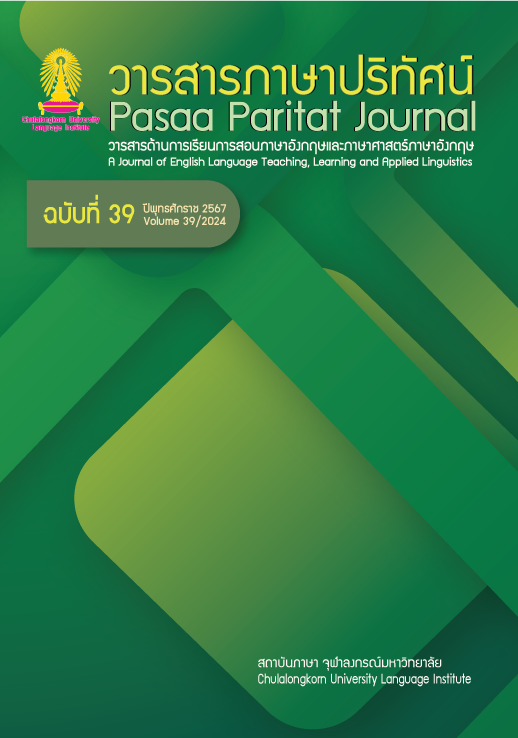Errors in Polysemy Translation of English Major Students
DOI:
https://doi.org/10.58837/CHULA.PPJ.39.2Keywords:
Translation, Translation Errors, Polysemy Translation, Types of Errors in Translation, Translation Teaching, Translation StrategiesAbstract
The purpose of this research is to present types of errors in translating polysemy by second-year English major students, using the categorization of errors according to American Translators Association. The analysis focuses on the frequency of errors related to meaning transfer. The research found that the most common error was misinterpreting words in context (84.38%), followed by using inappropriate words in the target language (62.5%), and adding or subtracting meanings from the original text (17.19%). The errors resulting from a lack of knowledge and understanding of the subject matter, unfamiliar idioms and figurative language, and incorrect comparisons were the least common (12.5%). Understanding the meaning of a word alone is not sufficient for translating polysemy. Translators must have knowledge of grammar, the ability to choose appropriate words, and an understanding of context.
References
ธัญญรัตน์ ปาณะกุล. (2562ก). การวิเคราะห์ข้อผิดพลาดในการแปลของผู้สอบคัดเลือกเข้าศึกษาในหลักสูตรศิลปศาสตรมหาบัณฑิต สาขาวิชาการแปล ภาษาอังกฤษ-ไทย มหาวิทยาลัยรามคำแหง. วารสารรามคำแหง ฉบับมนุษยศาสตร์, 38(2), 39–56.
__________. (2562ข). นักแปลกับปัญหาการแปลข้ามวัฒนธรรม. วารสารมนุษยศาสตร์ ฉบับบัณฑิตศึกษา, 9(1), 60–71.
พรชัย พรวิริยะกิจ และ วรินทร แดนดี. (2558). ข้อผิดพลาดในการแปลภาษาอังกฤษเป็นภาษาไทยของนักศึกษาสาขาวิชาภาษาอังกฤษเพื่อการสื่อสารสากล. วารสารสังคมศาสตร์, 4(2).
พิชญาภา สิริเดชกุล, อิสริยาภรณ์ ทองทับ, ดวงพร ทองน้อย, และรุจิรัตน์ ชัยแสง. (2565). ข้อผิดพลาดในการแปลภาษาอังกฤษเป็นภาษาไทยของนิสิตเอกภาษาอังกฤษ มหาวิทยาลัยนเรศวร. ภาษาปริทัศน์, 37, 23–40. https://so07.tci-thaijo.org/index.php/PasaaParitat/article/view/2037/1329
ภัทรา ปิณฑะแพทย์. (2565). ปัญหาการแปลภาษาอังกฤษเป็นภาษาไทย กรณีศึกษานิสิตสาขาวิชาภาษาอังกฤษธุรกิจ. วารสารวิชาการ คณะมนุษยศาสตร์และสังคมศาสตร์ มหาวิทยาลัยราชภัฏพระนคร, 6(1), 208–229.
ฤทัย พานิช. (2565). การวิเคราะห์ข้อผิดพลาดที่เกิดจากการแปลของนักศึกษา สาขาวิชาภาษาอังกฤษ มหาวิทยาลัยราชภัฏลําปาง. วารสารมนุษยศาสตร์ มหาวิทยาลัยนเรศวร, 19(1), 38–59.
วโรทัย สิริเศรณี และ นิรชา ชมภูราษฎร์. (2564). ข้อผิดพลาดในการแปลของนักศึกษาเอกภาษาอังกฤษชั้นปีที่ 3 มหาวิทยาลัยนครพนม. วารสารการบริหารนิติบุคคลและนวัตกรรมท้องถิ่น, 7(3), 34–45.
สุดฤทัย อรุณศิโรจน์. (2559). การวิเคราะห์ข้อผิดพลาดโดยใช้ทฤษฎีไวยากรณ์ระบบและหน้าที่: กรณีศึกษานักเรียนไทยที่เรียนภาษาอังกฤษเป็นภาษาต่างประเทศ. มนุษยศาสตร์ สังคมศาสตร์, 33(3), 18–38.
สุพรรณี อาศัยราช, ทัศนีย์ จันติยะ, และจิราภรณ์ กาแก้ว. (2560). ปัญหาและกลวิธีการแปลบทความทางการศึกษาจากภาษาอังกฤษเป็นไทยของนิสิตสาขาภาษาอังกฤษศึกษา. วารสารศาสตร์การศึกษาและการพัฒนามนุษย์, 1(1), 71–85. https://kuojs.lib.ku.ac.th/index.php/jehds/article/view/883/91
อัจฉริน จิตต์ปรารพ. (2565). การวิเคราะห์การแปลโฆษณาภาษาไทยเป็นภาษาอังกฤษของนักศึกษาวิชาเอกภาษาอังกฤษธุรกิจ. วารสารมนุษยศาสตร์ มหาวิทยาลัยนเรศวร, 19(1), 100–113. https://so03.tci-thaijo.org/index.php/jhnu/article/view/240928/173348
American Translators Association. (2022). Explanations of errors categories. https:www.atanet.org/certification/how-the-exam-is-graded/error-categories/?fbclid=IwAR2qKunZbO7gCfpPcR2v-hb42THNWaIk9DUBnloDX-7cxkPW7OKl3Afl6Mc.
Arsyi, S. (2019). An analysis of translation errors made by the 6th semester of English education program of English department UNNES [Under Graduates thesis, Universitas Negeri Semarang]. UNNES. https://lib.unnes.ac.id/id/eprint/34229
Aryati, R. (2016). Translation strategies of polysemy words in English-Indonesia divergent novel [Bachelor's thesis, Syarif Hidayatullah State Islamic University]. UIN Syarif Hidayatullah Institutional Repository. https://repository.uinjkt.ac.id/dspace/handle/123456789/36425
Carpuat, M., & Wu, D. (2007). Improving statistical machine translation using word sense disambiguation. Proceedings of the 2007 Joint Conference on Empirical Methods in Natural Language Processing and Computational Natural Language Learning (EMNLP-CoNLL) (pp. 61–72). Prague, Czech Republic. Association for Computational Linguistics.
Cúc, P. Thi K. (2018). An analysis of translation error: A case study of Vietnamese EFL students. International Journal of English Linguistics, 8(1), 22–28. https://doi.org/10.5539/ijel.v8n1p22
Dodigovic, M., Ma, C., & Jing, S. (2017). Lexical transfer in the writing of Chinese learners of English. TESOL International Journal, 12(1), 75–90.
Duklim, B. (2022). Translation errors made by Thai university students: A study on types and causes. rEFLections, 29(2), 344–360. https://doi.org/10.61508/refl.v29i2.259858
Koby, G. (2015). The ATA flowchart and framework as a differentiated error-marking scale in translation teaching. In Y. Cui & W. Zhao (Eds.), Handbook of Research on Teaching Methods in Language Translation and Interpretation (pp. 220–253). IGI Global.
Koman, H. N. N., Hartono, R., & Yuliasri, I. (2019). Translation errors in students’ Indonesian-English translation practice. English Education Journal, 9(2), 206–218. https://doi.org/10.15294/eej.v9i2.29372
Koutsoudas, A., & Korfhage, R. (1956). Mechanical translation and the problem of multiple meaning. Mechanical Translation, 3(2), 46–51.
Kurniawan, M., (2018). The analysis of interlingual and intralingual interference in children’s literature translation project. Celt: A Journal of Culture, English Language Teaching & Literature, 18(2), 229–244.
Larson, M. L. (1984). Meaning-Based Translation: A Guide to Cross-Language Equivalence. University Press of America.
Li, H. (2022). Representational development of polysemous words in bilingual mental lexicon: Socio-cognitive perspectives. Open Journal of Modern Linguistics, 12(3). https://doi.org/10.4236/ojml.2022.123020
Narulita, S. (2016). Error analysis on student’s narrative text in translation class of English department of Kutai Kartanegara University. Jurnal Intelegensia, 1(1), 13–29.
Navigli, R. (2009). Word sense disambiguation: A survey. ACM Computing Surveys, 41(2), 1–69.
Pethö, G. (2001). What is polysemy?—A survey of current research and results. In Pragmatics and the Flexibility of Word Meaning, (pp. 177–224). Brill. https://doi.org/10.1163/9780585474267_011
Phuc, N., & Diep, T. (2018). Strategies used by English interpretation and translation-majored seniors to solve linguistic difficulties in English-Vietnamese advertising translation. Can Tho University Journal of Science, 54(5), 23–29.
Putri, T. A. (2019). An analysis of types and causes of translation errors. Etnolingual, 3(2), 93–103. https://doi.org/10.20473/etno.v3i2.15028
Schäffner, C. (2004). Metaphor and translation: Some implications of a cognitive approach. Journal of Pragmatics, 36(7), 1253–1269.
Soltani, F., Nemati, A., & Yamini, M. (2020). An analysis of translation errors in 5 literary genres based on American Translation Association (ATA) framework. Cogent Arts & Humanities, 7(1). https://doi.org/10.1080/23311983.2020.1799732
Wongranu, P. (2017). Errors in translation made by English major students: A study on types and causes. Kasetsart Journal of Social Sciences, 38(2), 117–122. https://doi.org/10.1016/j.kjss.2016.11.003
Downloads
Published
How to Cite
Issue
Section
License
Copyright (c) 2024 Pasaa Paritat Journal

This work is licensed under a Creative Commons Attribution-NonCommercial-NoDerivatives 4.0 International License.



